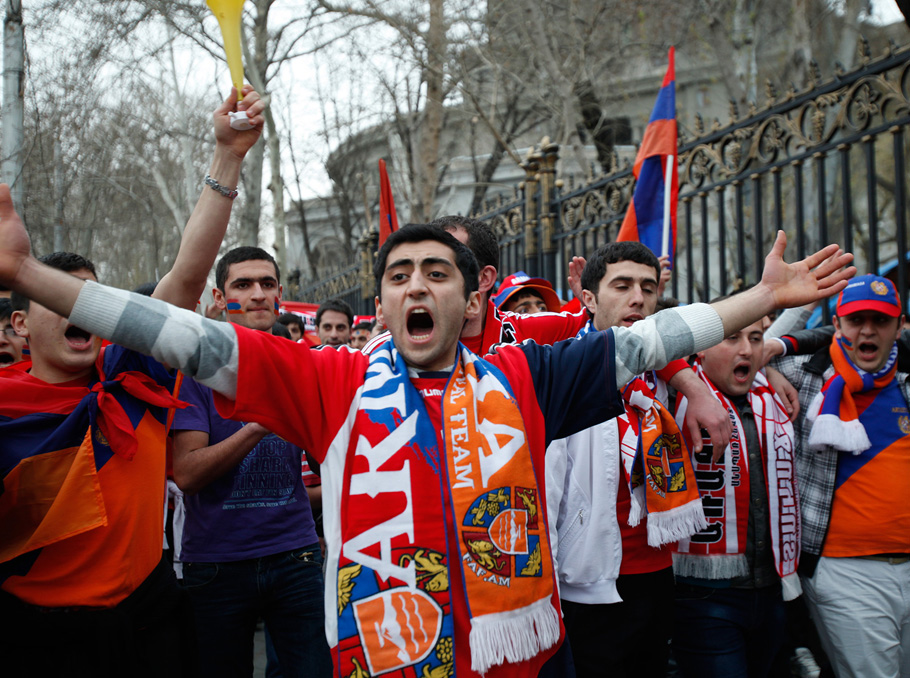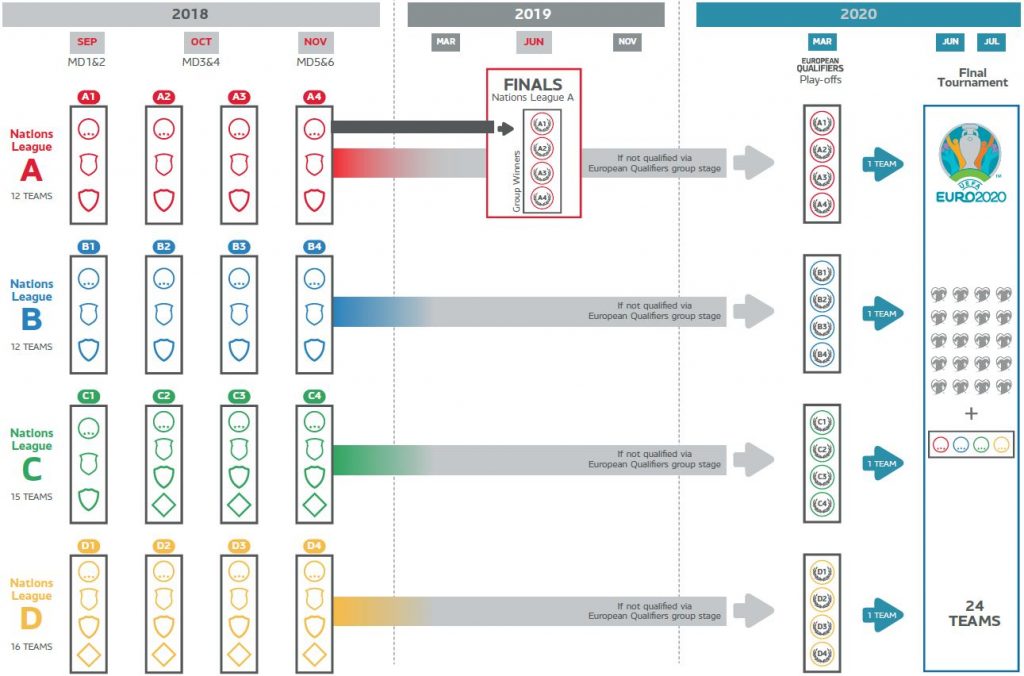Special to the Armenian Weekly
The Union of European Football Associations (UEFA) Nations League is a new competition for European teams. The competition’s introduction will result in a decrease in the number of meaningless international friendly matches and an increase in competitive fixtures between similarly ranked teams. The competition also aims to increase the viewership and general interest in international soccer, in response to waning interest in favor of the club competitions Europa League and Champions League.

The draw for the inaugural 2018-19 UEFA Nations League took place on Wed, Jan 17, 2018. Countries are split into groups across four leagues according to current UEFA ranking coefficients.
League A
Group 1: Germany, France, Netherlands
Group 2: Belgium, Switzerland, Iceland
Group 3: Portugal, Italy, Poland
Group 4: Spain, England, Croatia
League B
Group 1: Slovakia, Ukraine, Czech Republic
Group 2: Russia, Sweden, Turkey
Group 3: Austria, Bosnia and Herzegovina, Northern Ireland
Group 4: Wales, Republic of Ireland, Denmark
League C
Group 1: Scotland, Albania, Israel
Group 2: Hungary, Greece, Finland, Estonia
Group 3: Slovenia, Norway, Bulgaria, Cyprus
Group 4: Romania, Serbia, Montenegro, Lithuania
League D
Group 1: Georgia, Latvia, Kazakhstan, Andorra
Group 2: Belarus, Luxembourg, Moldova, San Marino
Group 3: Azerbaijan, Faroe Islands, Malta, Kosovo
Group 4: FYR Macedonia, Armenia, Liechtenstein, Gibraltar
The four group winners of the top-ranked League A will qualify for the Nations League Finals in June 2019. Two single-leg semifinals, a third-place playoff, and a final match will determine the overall winner. Group winners from Leagues B, C, and D will gain promotion to the higher levels, while teams propping up each group table will be relegated. Since Group 1 of League C has fewer teams than the other groups in League C, the three fourth-placed teams and the worst third-placed team will be relegated.
The second edition of the Nations League season will take place in 2020-21.
Another feature of the competition, and one that should be of keen interest to Armenian fans, will be a secondary qualifying route into Euro 2020 for four teams, one from each League A/B/C/D. That avenue of qualification will be separate from the standard Euro 2020 qualifying campaign.
The regular qualifying format will remain largely the same but, rather than the best third-placed teams advancing to the play-offs as in years past… that stage will now be reserved for the 16 Nations League group winners. If any of the 16 teams in question have already qualified for Euro 2020 through the regular route, their place will be taken by the next best-ranked team. Four countries from each of the four leagues will compete in two single-legged semifinals and a final to secure the four Euro 2020 berths up for grabs. Most importantly, this avenue of qualification assigns one berth to each league, which means that teams competing in League D, those teams that would normally struggle in the regular qualifying format, now have a chance to qualify for the finals tournament by pitting their skills against similarly ranked nations.
This is an altogether positive development for the European Championships, a competition that has evolved over the years. Along with CONMEBOL, the South American confederation, UEFA can be considered to be of the highest standard among all confederations in FIFA. Historically, this has made the European Championships arguably harder to qualify for, and win, compared with the World Cup. Teams reaching the European Championships tend to be the cream of the crop from UEFA, whereas the World Cup (rightfully) allocates qualification berths to weaker confederations to ensure the competition is truly global. That adds to the romance of the competition, for sure, but increases the difficulty for lower-seeded European countries to qualify from UEFA, and favors countries from other confederations that are most likely lower in the FIFA rankings.
The point is, the European Championships was, at one time, a best-of-the-best competition. For example, Euro 1992 had eight participating countries, seven of which gained qualification alongside the automatic berth of the host nation. That competition represented only 20 percent of the nations in UEFA at that time. With the breakup of the Soviet Union and an increase in the number of competing nations, the tournament was expanded to 16 teams in 1996. However, the tournament still only had room for around one-third of the confederation’s nations, not to mention subsequent years where two nations hosted the tournament and thus gained automatic qualification for themselves while reducing the number of available berths for qualifiers.
Referring to the included table, in the 20-year period between 1992 and 2012, a span of six tournaments, there were only three occasions where lower-seeded nations qualified: i.e., teams drawn from seeding pots four or lower. The 2016 edition of the tournament, which further expanded the participation to 24 teams, was somewhat of an anomaly in terms of lower-seed qualifications. Four of the 24 participating nations qualified after being drawn from pots four and five. If that was truly an outlying case, a regression to the mean is expected. Therefore, a similar pattern of qualification failure will be seen for lower-seeded teams in 2020 and beyond. That is why the UEFA Nations League and its back-door path to Euro 2020 qualification is a very welcome development for nations of League C, and most definitely nations of League D. It will have Armenian fans sizing up the League D opposition and fancying their chances.

When are the matches?
UEFA Nations League
Match day 1: 6–8 Sept. 2018
Match day 2: 9–11 Sept. 2018
Match day 3: 11–13 Oct. 2018
Match day 4: 14–16 Oct. 2018
Match day 5: 15–17 Nov. 2018
Match day 6: 18–20 Nov. 2018
*Group winners advance to Euro2020 playoffs (16 teams, four from each League)
League A Finals draw: Dec. 2018
League A Finals: 5–9 June 2019
Euro 2020 Qualifying
Match day 1 21–23 March 2019
Match day 2 24–26 March 2019
Match day 3 7–8 June 2019
Match day 4 10–11 June 2019
Match day 5 5–7 Sept. 2019
Match day 6 8–10 Sept. 2019
Match day 7 10–12 Oct. 2019
Match day 8 13–15 Oct. 2019
Match day 9 14–16 Nov. 2019
Match day 10 17–19 Nov. 2019
*Nations League A/B/C/D Group Winners (16 teams total, four per league)
Euro 2020 Playoff draw: 22 Nov. 2019
Euro 2020 Playoff Semifinals 26–28 March 2020
Euro 2020 Playoff Finals 29–31 March 2020



Euro 2020 Playoff Semifinals 26–28 March 2020
Euro 2020 Playoff Finals 29–31 March 2020
Question: how should the 2 games in semifinals (1 at home, 1 away) be played in 3 days between 26–28 March 2020?
The semi finals are not over two legs, they are a one-off game.